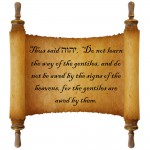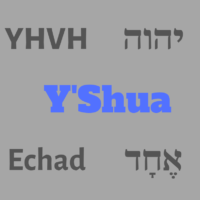In the Bible we see a clear description of the relationship between YHVH and His people. This relationship has gone  through many ups and downs throughout the history of the Bible. The rules for this relationship are defined in the Bible by the means of a covenant between YHVH and His people. Thus it is of the utmost importance for us to understand these covenants if we would like to understand the relationship that YHVH wants with us. Covenants are not something unique to the Bible. On the contrary, we find many examples of extra-biblical documents that describes covenants where we see clear correlation between the form and content of covenants in the Bible and covenants used by other nations. This topic is huge and many volumes have been written about it by many experienced scholars. Thus we will need to break this into smaller parts if we want to be able to comprehend it all. Before we get into the discussions of the different covenants and what they mean it is most important that we get to grips with the basics. This article will focus on some of the basic terms and concepts regarding covenants in the time of the Bible.
through many ups and downs throughout the history of the Bible. The rules for this relationship are defined in the Bible by the means of a covenant between YHVH and His people. Thus it is of the utmost importance for us to understand these covenants if we would like to understand the relationship that YHVH wants with us. Covenants are not something unique to the Bible. On the contrary, we find many examples of extra-biblical documents that describes covenants where we see clear correlation between the form and content of covenants in the Bible and covenants used by other nations. This topic is huge and many volumes have been written about it by many experienced scholars. Thus we will need to break this into smaller parts if we want to be able to comprehend it all. Before we get into the discussions of the different covenants and what they mean it is most important that we get to grips with the basics. This article will focus on some of the basic terms and concepts regarding covenants in the time of the Bible.
What is a covenant?
The very first thing we need to do is to get a clear definition of what a covenant is and equally important, what it is not! A lot of confusion regarding covenants start of with a wrong idea of what a covenant is. We are also confused by the terms that we are taught and what these imply. At the same time we sit with the typical problem of a Greek mindset when reading a Hebrew document. All these factors add to our warped ideas of a covenant and it’s meaning.
A contract is entered into with the purpose of creating a legal obligation by involved parties and this document defines the legal rights of all parties involved. Thus it requires performance from all parties. If a party defaults on it’s obligation, the other party has the right to restitution. The contract will terminate if all obligations have been fulfilled, an escape clause of the contract comes into force or if the contract is set aside. A contract may legally be set aside for a number of reasons including unenforceability or ineffectiveness. An escape clause in a contract allows a party in the contract to avoid having to perform the contract. An example of this is called Force Majeure or Acts of God, which are deemed to be natural events that the party has no control over and could prevent them from performing. This could be for example a natural disaster (flood) that prevents a building contractor from completing a building on time.
A testament (or last will) is a document in which a person appoints one or more persons to transfer his/her property at death. Technically a will is only created in relation to property and testament with regard to personal possessions. Thus the reason for the common term of “The last Will and Testamentâ€. The person creating the will always has sole right to alter or cancel the document. None of the other parties in the document need to be informed of it’s creation, alteration or revocation. The latest version of a will and testament always supersedes all previous versions. Thus, only the latest version has any value.The conditions of the document only become active upon the death of the person that created the document. Although the concept of transferring of blessings is seen in the Bible (Isaac in Gen 27 and Jacob in Genesis 48) we are also familiar with the concept of double portion for the first born. This would indicate some rules of inheritance, but not necessarily a legal obligation. These blessing were done in person and not via a document in both these examples. From this we can see that we really should not be speaking of the “Old Testament†or the “New Testament†because these document do not become active at the death of YHVH. If the argument is that Y’shua died and by that we have inherited, would the testament not been voided with His resurrection?
Now that we know what some other terms really mean, let us focus on the covenant. Let us start by looking at a formal definition.
Manser, M. H. (1999). Dictionary of Bible Themes: The Accessible and Comprehensive Tool for Topical Studies. London: Martin Manser.
What you should notice from this definition:
- It is about a relationship between the parties
- There are no performance obligation thus there can be no termination of the agreement
This means that a covenant is created to establish and formalize a relationship between two or more parties. A covenant contains a list of blessings for keeping the relationship and curses for not keeping the relationship. These curses were quite severe in order to encourage the faithfulness to the relationship. As I stated earlier we know these things not only from the covenants described in the Bible but also by some documents from the Hittites, Egyptians and Assyrians. A covenant is everlasting with no appointed end-time, as the relationship is maintained throughout the subsequent generations.
It is important to understand that some covenants come with conditions while others are unconditional. We will shortly look at the different forms of covenants that were in existence. This is an important fact that distinguishes a covenant from a contract. Contracts, by their very definition, come with conditions either to create obligation or to govern the outcome of the contract. Covenants do not need conditions as the focus on a relationship – they are made because the involved parties desire to do so.
We also need to note some very specific differences of covenants compared to contracts or testaments. A covenant does not dissolve. It is an everlasting relationship that is created. Even the covenants between men span multiple generations. We will see later that it is clear in scripture that the condition of the covenant is still kept after the death of one of the contracting parties. Never in the Scripture do we read of a covenant being dissolved. We do read about the curses of a covenant coming upon one of the two parties. We will discuss this in more detail when we talk about what happens when a covenant is broken.
In our modern times, one of the distinctions between a contract and a covenant is the seal that is placed upon a covenant. In history, this seal was the signet ring of the contracting parties. Today we see this seal still being used by government to promulgate new laws and also to sign apostille documents, which are the result of documents produced under the Apostille treaty. In Scripture, we find a good example of the irreversibility of a sealed document in the book of Esther.
Esther 3:8–10
8 Then Haman said to King Ahasuerus, “There is a certain people scattered and dispersed among the peoples in all the provinces of your kingdom; their laws are different from those of all other people and they do not observe the king’s laws, so it is not in the king’s interest to let them remain. 9 “If it is pleasing to the king, let it be decreed that they be destroyed, and I will pay ten thousand talents of silver into the hands of those who carry on the king’s business, to put into the king’s treasuries.†10 Then the king took his signet ring from his hand and gave it to Haman, the son of Hammedatha the Agagite, the enemy of the Jews.
The decree passed by Haman could not be reversed, even by the king. A new decree had to be passed to allow the Jews to defend themselves.
Esther 8:1–8
1 On that day King Ahasuerus gave the house of Haman, the enemy of the Jews, to Queen Esther; and Mordecai came before the king, for Esther had disclosed what he was to her. 2 The king took off his signet ring which he had taken away from Haman, and gave it to Mordecai. And Esther set Mordecai over the house of Haman. 3 Then Esther spoke again to the king, fell at his feet, wept and implored him to avert the evil scheme of Haman the Agagite and his plot which he had devised against the Jews. 4 The king extended the golden scepter to Esther. So Esther arose and stood before the king. 5 Then she said, “If it pleases the king and if I have found favor before him and the matter seems proper to the king and I am pleasing in his sight, let it be written to revoke the letters devised by Haman, the son of Hammedatha the Agagite, which he wrote to destroy the Jews who are in all the king’s provinces. 6 “For how can I endure to see the calamity which will befall my people, and how can I endure to see the destruction of my kindred?†7 So King Ahasuerus said to Queen Esther and to Mordecai the Jew, “Behold, I have given the house of Haman to Esther, and him they have hanged on the gallows because he had stretched out his hands against the Jews. 8 “Now you write to the Jews as you see fit, in the king’s name, and seal it with the king’s signet ring; for a decree which is written in the name of the king and sealed with the king’s signet ring may not be revoked.â€
Another modern example of the everlasting nature of a covenant is found in “Covenants Running with the Land†which is still in use today. Here is a current definition of such this legal format.
The next aspect of a covenant that is very important is that a covenant can be expanded and renewed. We will see in Scripture how the covenant between David and Jonathan was renewed and expanded. Furthermore, in Joshua 24 we see that Joshua had the nation renew their covenant with YHVH
Joshua 24:19–25
19 Then Joshua said to the people, “You will not be able to serve the Lord, for He is a holy God. He is a jealous God; He will not forgive your transgression or your sins. 20 “If you forsake the Lord and serve foreign gods, then He will turn and do you harm and consume you after He has done good to you.†21 The people said to Joshua, “No, but we will serve the Lord.†22 Joshua said to the people, “You are witnesses against yourselves that you have chosen for yourselves the Lord, to serve Him.†And they said, “We are witnesses.†23 “Now therefore, put away the foreign gods which are in your midst, and incline your hearts to the Lord, the God of Israel.†24 The people said to Joshua, “We will serve the Lord our God and we will obey His voice.†25 So Joshua made a covenant with the people that day, and made for them a statute and an ordinance in Shechem.
Forms of Covenants
Throughout the Bible and the literature of this time period, we see examples of different forms of covenants being made. Each one of these had a difference in the parties involved and the conditions for keeping the relationship intact.
Parity Covenant
The first form is the covenant where all parties involved in the covenant are in equal standing when entering into the covenant. This is typically the form that is used to take personal relationships to a next level. The parity covenant was also frequently used between groups of people, not only individuals. This is the way that families or clans turned into tribes. If one family were farmers and another, skilled hunters they could form a covenant whereby the one party brings their hunting or fighting skills to protect the other while securing for themselves a reliable supply of food. Because the parties need to be of approximately equal standing, it would be impossible for man to enter such a covenant with YHVH.
We can find a number of examples in Scripture of such covenants. The covenant between Jacob and Laban is an example that shows the process of making a covenant in patriarchal times (Gen 31:44-54). We see that they had a meal, called witnesses, put up a sign of the covenant and agreed on the conditions. Please note that the blessings, here are that they will both live in peace; Laban will bless his children and grandchildren. The only “curse†in this covenant is that YHVH will judge between them if one of them do not maintain this relationship between the two families.
David and Jonathan also formed a covenant as described in – 1 Sam 18:1-4 and 1 Sam 20:16. The reason this covenant was made is simply because “Then Jonathan made a covenant with David because he loved him as himself.” . In 1 Sam 20, we see how Jonathan does everything he could to save the life of David and in 2 Sam 1, we see the lamentation of David when he hears of the death of Saul and Jonathan. We also see that David honors this covenant even after the death of Jonathan by protecting his son in 2 Samuel 21:7 and then later David looks after his son as one of his own family (2 Samuel 9:7). Two things that are important to notice in this covenant is that the covenant is renewed and the conditions are made more specific.
1 Samuel 18:1–4
1 Now it came about when he had finished speaking to Saul, that the soul of Jonathan was knit to the soul of David, and Jonathan loved him as himself. 2 Saul took him that day and did not let him return to his father’s house. 3 Then Jonathan made a covenant with David because he loved him as himself. 4 Jonathan stripped himself of the robe that was on him and gave it to David, with his armor, including his sword and his bow and his belt.
Then later we see that Jonathan renews the covenant with David and makes the conditions of the covenant more specific.
1 Samuel 20:16–17
16 So Jonathan made a covenant with the house of David, saying, “May YHVH require it at the hands of David’s enemies.†17 Jonathan made David vow again because of his love for him, because he loved him as he loved his own life.
Another example of this is the covenant made between King Solomon and King Hiram of Tyre.
1 Kings 5:12
12 YHVH gave wisdom to Solomon, just as He promised him; and there was peace between Hiram and Solomon, and the two of them made a covenant.
We do not see any attack by a king of Israel or Judah on Tyre after this. However, we do find that the Tyre did not keep to the covenant. The result of this was that YHVH judged them by sending Shalmanezer and later Nebuchadnezzar to destroy their city, which they did not manage, but it was eventually destroyed by Alexander the great after a siege of seven months. This was prophesied by many prophets, including Amos.
Amos 1:9–10
9 Thus says the Lord, “For three transgressions of Tyre and for four I will not revoke its punishment, Because they delivered up an entire population to Edom And did not remember the covenant of brotherhood. 10 “So I will send fire upon the wall of Tyre And it will consume her citadels.â€
Suzerainty Covenant
The most common form of a covenant found during the time period of the Tanakh was what is today referred to as the Suzerainty covenant. This was a covenant made between a stronger (Suzerain) and a weaker (vassal) party. The most common instance of this was the agreement made between two nations after a war where one conquered the other. The Hittites, Egyptians, and Assyrians were suzerains to the Israelites.
To date, 29 suzerainty covenants have been found from the second millennium B.C. of which 7 were made by the Hittites. The remainder are in Sumerian / Akkadian. These normally have the same basic elements.
- Preamble: Identifies the parties involved in the treaty
- Prologue: Lists the deeds already performed by the Suzerain on behalf of the vassal
- Stipulations: Terms to be upheld by the vassal for the life of the treaty
- Provision for annual public reading: A copy of the treaty was to be read aloud annually in the vassal state for the purpose of renewal
- Divine witness to the treaty: These usually include the deities of both the Suzerain and the vassal
- Blessings if the stipulations of the treaty are upheld and curses if the stipulations are not upheld
- Sacrificial Meal / Ceremony: Both parties would share a meal to show their participation in the treaty
Later Assyrian treaties from the first millennium BC were much harsher, only including curses without any blessings.
In our later studies we will see that the same formula is used in the Scriptures to define the relationship between YHVH and His people.
Royal Grant Covenant
This covenant is also a covenant made between a stronger and a weaker party. However, in this case, it is not the rights of the Suzerain (stronger party) that is protected, but the rights of the vassal (weaker party). The curses in this covenant is against anybody that would infringe upon the rights of the vassal. The other difference we see is that this covenant is normally the result of the loyalty of the vassal towards the Suzerain. Thus, it is seen as a reward for loyalty and is guaranteed by the stronger party. We also see that this reward is normally land and dynasty. This means that the land is not only the property of the vassal but also of his descendants. This implies that as part of this covenant the boundaries and characteristics are clearly defined.
The land is of course not given unconditionally. Although in most cases it is not explicitly documented, the continued loyalty of the vassal is assumed. If the vassal decides to no longer be loyal to the Suzerain, the Suzerain may decide to revoke the privilege.
The Suzerainty Covenant was ratified in a ceremony in which both parties would walk between the split animal pieces, but a Royal Grant was ratified in a ceremony in which the Suzerain would walk between the pieces alone.
Types of covenants
Apart from the forms of covenants that exist we also see different stages of the relationship being reflected in various types of covenants. These types, tell us more about the level of intimacy that existed between the parties involved in the covenant. Since covenants are progressive, and can be renewed, it is possible for a relationship to progress through all these types of covenants. There is normally additional commitment in the relationship before it moved to the next type. Every covenant thus has a form and a type.
Blood Covenant
The first of these types is the most commonly known, the blood covenant. This is also known as the servant hood covenant. It requires the shedding of blood (either of the involved parties or of an animal) to ratify the covenant. A blood covenant between humans is a very old tradition that has been well recorded throughout history and is still being practiced in many cultures today. It is frequently done by making a cut in the flesh of the parties entering the covenant and then allow the blood of the parties to mix, thereby symbolizing the lives that have now become one.
This is also the origin of the handshake. The custom was to make a cut in the palm of hands of the parties entering into the covenant, and then they press their palms together allowing the blood to mix. Today, we do not do the cut anymore but still use the handshake to greet a friend or confirm an arrangement.
By entering into a blood covenant with a person (or group) YHVH is asking him to serve and obey Him. For keeping this covenant, there will be blessings and for not keeping it, there will be curses.
An example of the Suzerian form of a blood covenant is the covenant with the nation of Israel at Sinai. We see that the blood of the sacrifices is sprinkled on the people and the altar.
Exodus 24:4–6
4 Moses wrote down all the words of the Lord. Then he arose early in the morning, and built an altar at the foot of the mountain with twelve pillars for the twelve tribes of Israel. 5 He sent young men of the sons of Israel, and they offered burnt offerings and sacrificed young bulls as peace offerings to YHVH. 6 Moses took half of the blood and put it in basins, and the other half of the blood he sprinkled on the altar.
An example of a Royal Grant Treaty as a blood covenant is the covenant that YHVH made with Abraham. Here we have a promise of land with well declared boundaries.
Genesis 15:17–21
17 It came about when the sun had set, that it was very dark, and behold, there appeared a smoking oven and a flaming torch which passed between these pieces. 18 On that day YHVH made a covenant with Abram, saying, “To your descendants I have given this land, From the river of Egypt as far as the great river, the river Euphrates: 19 the Kenite and the Kenizzite and the Kadmonite 20 and the Hittite and the Perizzite and the Rephaim 21 and the Amorite and the Canaanite and the Girgashite and the Jebusite.â€
We also see that the covenant was a blood covenant due to the sacrificial animals but, also that it is a Royal Grant as
- there is a promise for YHVH (Suzerain) to protect Abraham and his dynasty (vassal)
- there is a clearly defined piece of land in the covenant
- only the Suzerain has an obligation and thus only YHVH passes between the animals.
We will discuss these covenants in more detail later.
Salt Covenant
Once a blood covenant has been entered into the relationship of servant hood can evolve into a relationship of friendship. This is then when the next type of the covenant comes in, the salt covenant. This covenant is also called the covenant of hospitality or friendship. The name comes from the tradition of friends to mix their salt when breaking bread together. Once the salt is mixed and the meal completed, the only way to get back your salt would have been to separate each grain. This would be a near impossibility. Thus, once you enter this covenant you willingly share what is precious to you with a friend without the option to take it back.
In Genesis 18:1-15 we see Abraham breaking bread with YHVH.
Genesis 18:1–5
1 Now YHVH appeared to him by the oaks of Mamre, while he was sitting at the tent door in the heat of the day. 2 When he lifted up his eyes and looked, behold, three men were standing opposite him; and when he saw them, he ran from the tent door to meet them and bowed himself to the earth, 3 and said, “My Lord, if now I have found favor in Your sight, please do not pass Your servant by. 4 “Please let a little water be brought and wash your feet, and rest yourselves under the tree; 5 and I will bring a piece of bread, that you may refresh yourselves; after that you may go on, since you have visited your servant.†And they said, “So do, as you have said.â€
We also find that YHVH refers to Abraham as His friend.
Isaiah 41:8–9
8 “But you, Israel, My servant, Jacob whom I have chosen, Descendant of Abraham My friend, 9 You whom I have taken from the ends of the earth, And called from its remotest parts And said to you, ‘You are My servant, I have chosen you and not rejected you.
The other well-known salt covenant is the covenant with the descendants of Aaron, the Levites.
Numbers 18:19–20
19 “All the offerings of the holy gifts, which the sons of Israel offer to YHVH I have given to you and your sons and your daughters with you, as a perpetual allotment. It is an everlasting covenant of salt before YHVH to you and your descendants with you.†20 Then YHVH said to Aaron, “You shall have no inheritance in their land nor own any portion among them; I am your portion and your inheritance among the sons of Israel.
The Levites were already under a blood covenant with YHVH and because they chose Him after the incident with the golden calf, the relationship was moved to the level of friendship and confirmed with a salt covenant.
Sandal Covenant
The next type of covenant is not specifically mentioned in Scripture by its name. It is the sandal covenant or also referred to as the covenant of inheritance. The name originates from the custom to mark your property with worn-out sandals. These sandals were partially covered by rocks to keep them in place against the natural elements (wind and rain) No person would ever have dared to move these as this is forbidden in Torah (Deut 19:14). This covenant is thus the progression from a friend to a son or daughter who will inherit. We all know that the covenant of inheritance can only be kept in place as long as the servant hood and friendship remain situated properly. How often do we not hear stories of children being threatened with an exclusion from the will if there are not obedient or respectful of their parent. Sons and daughters always have special privileges over servants and even the best of friends
Marriage Covenant
The ultimate form of a covenant is the marriage covenant (Betrothal). This is the closest relationship you will ever experience as this is the point when the two parties of the covenant become one.
Genesis 2:24
24 For this reason a man shall leave his father and his mother, and be joined to his wife; and they shall become one flesh.
The precondition for a marriage covenant is exclusivity. A bride is faithful to her bridegroom, and the bridegroom is faithful to the bride. This is the ultimate relationship that YHVH wants with His people. He will be the husband who loves and protects the bride, and we must be the faithful bride to Him and Him alone.
Revelation 19:7–8
7 “Let us rejoice and be glad and give the glory to Him, for the marriage of the Lamb has come and His bride has made herself ready.†8 It was given to her to clothe herself in fine linen, bright and clean; for the fine linen is the righteous acts of the saints.
Next time
Today we have started with the very basics of what the terms and terminologies of covenants are. One last topic that we need to cover before we start to study the individual covenants, is the concept of breaking a covenant. Thus, in the next article, we will look at this final introductory topic and then also list a more comprehensive list of the covenants contained in the Scriptures.
References
- Hebrews Through a Hebrew’s Eyes: Hope in the Midst of a Hopeless World; Sacks, Stuart.; Baltimore, MD: Messianic Jewish Publishers, 1995.
- Vol. Volume 10, The Superiority of the New Covenant: Hebrews. Study Guide Commentary Series; Utley, Robert James; Marshall, Texas: Bible Lessons International, 1999.
- Walking in the Light – Volume 4 – Covenants; Bennett, Todd D; Shema Yisrael Publishers; ISBN 0-9768659-7-1
- Jackson, Cathy; A Standing Invitation; Xulon Press, 2010; ISBN:978-1594675294
- Theological Dictionary of the New Testament. Edited by Gerhard Kittel, Geoffrey W. Bromiley and Gerhard Friedrich. electronic ed. Grand Rapids, MI: Eerdmans, 1964-.
- Lost in translation – Volume 1 – Rediscovering the Hebrew roots of our faith; John Klein & Adam Speaks; Covenant Research Institute; ISBN 978-1-58930-199-3
- The Covenant of Grant and The Abrahamic Covenant; Timm Hegg; http://www.torahresource.com









Leave a Reply